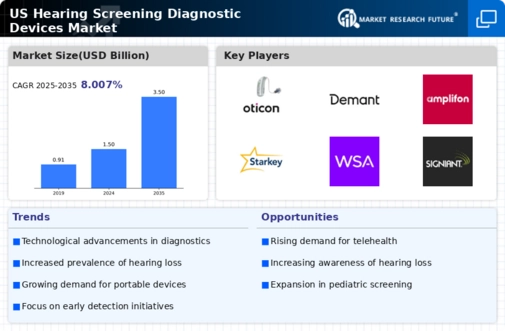The competitive landscape of the US Hearing Screening Diagnostic Devices Market is characterized by a dynamic array of companies that are consistently evolving to address the growing demand for advanced auditory technologies. With rising awareness of hearing health among the population and an increasing prevalence of hearing impairments, the market is marked by intense competition, innovative product offerings, and strategic partnerships. This space is shaped by players who focus on developing cutting-edge devices and services to enhance screening accuracy and patient experience.
As regulatory standards and consumer expectations continue to rise, manufacturers are also investing in research and development to introduce novel solutions tailored to both healthcare providers and end-users, fostering competitiveness and growth in the market.
Oticon has carved a notable niche for itself within the US Hearing Screening Diagnostic Devices Market by emphasizing its commitment to innovation and quality. Renowned for its user-friendly hearing aids and diagnostic instruments, Oticon has managed to establish a robust presence through a combination of advanced technology and superior customer support. The company's strength lies in its dedication to improving user experience, backed by a portfolio that focuses on delivering reliable diagnostic accuracy in hearing assessments. This commitment is reflected in its ongoing training and education initiatives for healthcare professionals, ensuring that users receive the best possible care.
Furthermore, Oticon’s strategic collaborations with healthcare institutions have further enhanced its visibility and reputation in the market, enabling the company to stay competitive in an evolving landscape.
Demant, another key player within the US Hearing Screening Diagnostic Devices Market, has a diverse range of offerings designed to meet the needs of audiologists and patients alike. Its product line includes advanced hearing aids, diagnostic tools, and comprehensive audiological solutions that cater specifically to the unique demands of the US market. Demant's strengths stem from its focus on research and development, which allows the company to continuously innovate and improve its product offerings. Additionally, Demant has strategically expanded its presence in the US through various mergers and acquisitions, enhancing its portfolio and operational capabilities.
This includes key partnerships that not only broaden its reach but also optimize its distribution channels. By maintaining high standards of quality and fostering a commitment to customer-centric solutions, Demant has solidified its position in the market as a leading provider of hearing screening diagnostic devices in the US, capable of addressing both current and future healthcare challenges.






















Leave a Comment